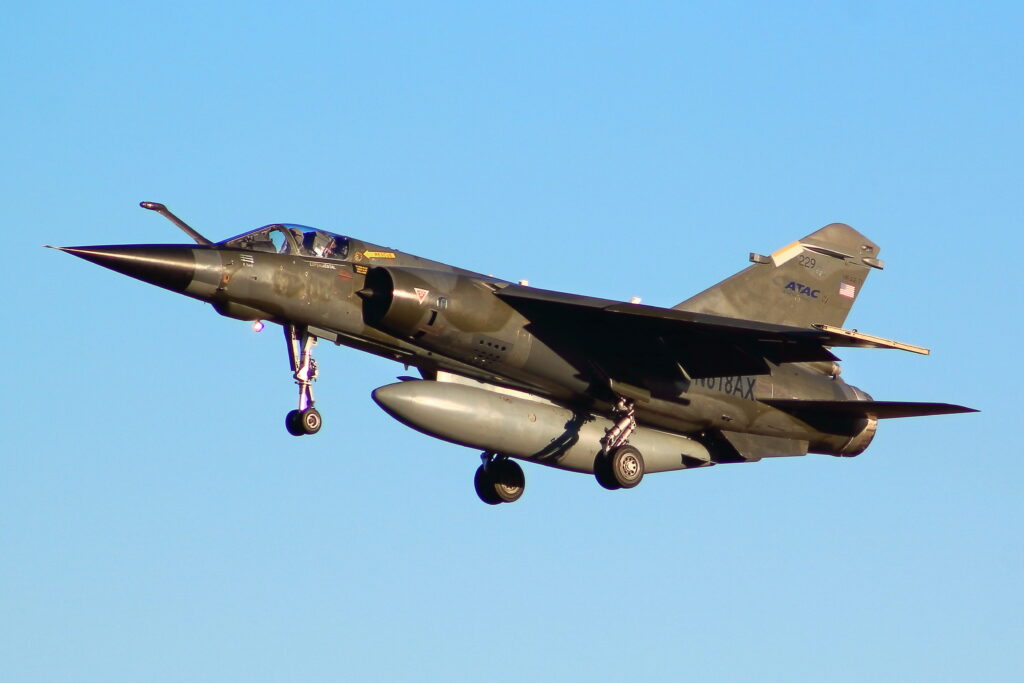
ATAC F1 Mirage
WASHINGTON: The Air Force has awarded ATAC, Textron Systems’ military airborne training unit, a contract to provide adversary air combat training to F-22 and F-35 pilots at Eglin AFB, Florida — making it the biggest winner in the initial round of the service’s overarching effort to outsource pilot training that eventually could be worth billions.
“When you add up the number of either sorties or flight hours — which of course the money goes with because you get paid by how much you fly — then you’re at more than 50 percent of the total,” Richard Zins, ATAC vice president of business operations, told me today.
Under the new award, worth $94 million, ATAC will use its fleet of upgraded and refurbished Dassault Aviation Mirage F1 fighters to play the ‘bad guys’ in mock combat against Air Force pilots in more than 1,100 sorties per year for up to four-and-a-half years, ATAC explained in a press release today. The training is expected to begin in January 2021.
The award is the last of six Red Air training ‘tasking orders’ solicited this year under the the Air Force’s Combat Air Forces (CAF)/Contracted Air Support (CAS) program. The Air Force last October chose seven contractors to compete under an overarching indefinite delivery, indefinitely quantity (ID/IQ) contract, worth up to $6.4 billion, for both adversary air combat training and close air support training. As colleague Rachel Cohen explained in March, the ID/IQ originally envisioned 40,000 hours of adversary air combat training at 12 locations.
The ID/IQ also envisioned close air support training at up to 10 facilities, of which three were have been awarded this year.
ATAC in July nabbed the awards for CAF training at Holloman AFB, New Mexico and Luke AFB in Arizona. Together they are worth up to $240 million. ATAC’s flight operations at Holloman AFB are starting up, and will commence at Luke AFB by next month, Zins said.
The company also is providing close air support training, playing as surrogate ‘Blue Forces,’ for Air Force Special Operations Command Joint Terminal Air Controllers (JTACs) on the ground under the CAF/CAS program under an Aug. 10 tasking order worth $19.9 million, an Air Force spokeperson told me in an email today.
Alongside ATAC’s July award, two other companies — Draken International and Tactical Aircraft Support Inc (TACAIR) — also were awarded adversary air training tasking orders under the CAF/CAS program.
Draken International is providing training at two sites: for F-15E pilots at Seymour Johnson AFB in North Carolina, under an award worth up to $74.5 million; and for Air National Guard F-16 pilots at Kelly Field in Texas, under an award worth up to $28.2 million. Draken has a mixed fleet of aircraft for use in training, including the upgraded Mirage F1M, the Aero Vodochody L-159E Honey Badger, the Douglas A-4 Skyhawk, and the Cheetah produced by South African firm Denel Aviation. The company further won a contract in 2018 to fly as aggressors at the Air Force Weapons School and Red Flag exercises at Nellis AFB in Nevada.
TACAIR won a contract up to $90.4 million over four and a half years for training of F-15C/D pilots at Kingsley Field Air National Guard Base in Oregon. TACAIR is providing the training using its fleet of F-5ATs Advanced Tigers, which it also uses to train Navy pilots including at the Naval Fighter Weapons School (NFWS), i.e. TOPGUN.
Industry officials are expecting the service to award another tranche of tasking orders next year. However, so far, the service has released no information about the scope or timing of a second round of training awards (and Air Force PAO is still working on my inquiry.)
Zin explained that the market is booming for commercially provided airborne training because of the Air Force’s enormous needs, driven in large part by its continued pilot shortage. In addition, Zin explained, training for pilots of fifth generation aircraft — especially the F-35, but also the F-22 — requires many more flying hour than older fighters. Another driver is the fact that when the Air Force dedicates an aircraft to pilot training, it takes a toll on combat readiness. Lastly, Zin said, it is more cost-effective to use outside contractors for adversary air training — and given that many of the pilots employed in the industry are retired military pilots.
The CAF/CAS program awards for adversary training have “more than doubled” ATAC’s business alone, he said. “”It’s a massive increase to the industrial base of the companies providing this service.”
China’s new H-20 stealth bomber ‘not really’ a concern for Pentagon, says intel official
“The thing with the H-20 is when you actually look at the system design, it’s probably nowhere near as good as US LO [low observable] platforms, particularly more advanced ones that we have coming down,” said a DoD intelligence official.


























